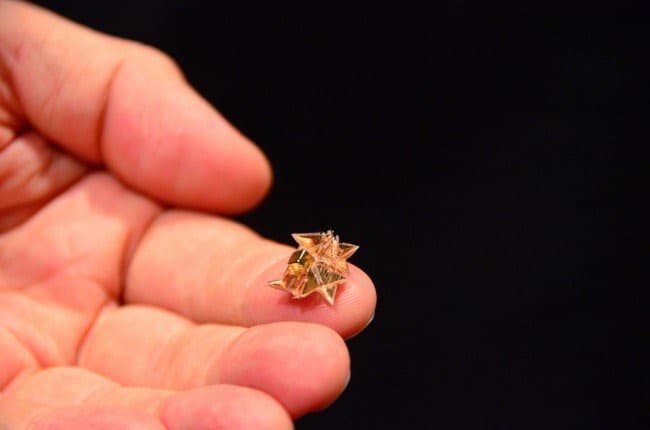MIT Researchers Create Tiny 'Self-Destructive' Robots
A team of researchers at MIT has invented tiny robots that are self-destructive and capable of crawling up a person's arm, climbing up ropes and can carry loads twice their weight. Developed with the aim to get dissolved inside a human body, these robots made debut at IEEE Robotics and Automation Society’s 2015 ICRA conference in Seattle, Washington. The miniature robots weigh less than a gram, but are much powerful for their size and have been under development at MIT since 2012. Researchers used PVC sheets, layers of polystyrene (that were precision cut using laser) and tiny magnets to help the robots crawl/move over the surface.

These origami-like structures have no internal circuitry and work under their under own power. Once their navigation is complete, they are heated on a heating element and folded up for 60 seconds. The robots consist of small electromagnetic coils with external magnetic fields and can vibrate and oscillate with speed of up to four cm/second.
There are a few challenges that researchers are facing after developing these miniature wonders. The material used for making these robots cannot be completely dissolved inside the human body. The robots when dipped into acetone solution and get dissolved, but tiny magnets are left behind. Therefore, the researchers aim to create these robots from the biodegradable materials which can be helpful in medical sciences for treatments of patients by injecting these robots in their bloodstream. For this, a paper from MIT researchers titled, “biodegradable counterparts,†will have to be used. The next big challenge for the researchers is to make these robots 'self-sufficient'. It means the robots can work on entirely on their own to heal the patients and treat them wherever they can inside the human body.
If these robots can tackle these challenges, they can cause breakthrough in the field of medicine and surgery. What do you think about these tiny robots developed by MIT? Share your views with us in the comments' section below.
Via: <a href="https://guardianlv.com/2015/05/robots-that-heal-and-then-self-destruct/" target="_blank" rel="nofollow noopener noreferrer">Robots That Heal and Then Self-Destruct - Guardian Liberty Voice</a>

These origami-like structures have no internal circuitry and work under their under own power. Once their navigation is complete, they are heated on a heating element and folded up for 60 seconds. The robots consist of small electromagnetic coils with external magnetic fields and can vibrate and oscillate with speed of up to four cm/second.
There are a few challenges that researchers are facing after developing these miniature wonders. The material used for making these robots cannot be completely dissolved inside the human body. The robots when dipped into acetone solution and get dissolved, but tiny magnets are left behind. Therefore, the researchers aim to create these robots from the biodegradable materials which can be helpful in medical sciences for treatments of patients by injecting these robots in their bloodstream. For this, a paper from MIT researchers titled, “biodegradable counterparts,†will have to be used. The next big challenge for the researchers is to make these robots 'self-sufficient'. It means the robots can work on entirely on their own to heal the patients and treat them wherever they can inside the human body.
If these robots can tackle these challenges, they can cause breakthrough in the field of medicine and surgery. What do you think about these tiny robots developed by MIT? Share your views with us in the comments' section below.
Via: <a href="https://guardianlv.com/2015/05/robots-that-heal-and-then-self-destruct/" target="_blank" rel="nofollow noopener noreferrer">Robots That Heal and Then Self-Destruct - Guardian Liberty Voice</a>
0
